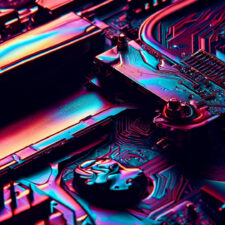CNC (Computer Numerical Control) technology has come a long way in the last few decades. It has revolutionized the manufacturing industry and has made it possible to produce complex parts and components with precision and accuracy. As technology continues to advance, CNC machines are becoming more sophisticated, efficient, and cost-effective. In this article, we will explore some of the new trends in CNC technology that are shaping the future of manufacturing.

1. Additive Manufacturing
Additive manufacturing, also known as 3D printing, is a process where a digital model is turned into a physical object by adding layer upon layer of material. While it has been around for some time, it has recently become more accessible and affordable. CNC machines can now be used to create parts with complex geometries using a wide range of materials, including plastics, metals, and ceramics.
2. Hybrid Manufacturing
Hybrid manufacturing is a combination of both additive and subtractive manufacturing processes. It allows manufacturers to take advantage of the benefits of both techniques while minimizing their drawbacks. CNC machines can now switch between additive and subtractive processes seamlessly, allowing for more efficient and cost-effective production.
3. Artificial Intelligence
Artificial intelligence (AI) is becoming more prevalent in CNC technology. With AI, CNC machines can learn from their past performance and make adjustments to improve their accuracy and efficiency. They can also detect defects in parts and make corrections in real-time, reducing waste and increasing productivity.
4. Internet of Things
The Internet of Things (IoT) is a network of physical devices, vehicles, and other objects that are embedded with sensors, software, and other technologies that enable them to connect and exchange data. CNC machines can now be connected to this network, allowing manufacturers to monitor and control their machines remotely. This means that they can detect and fix issues in real-time, reducing downtime and increasing efficiency.
5. Cloud Computing
Cloud computing is a technology that allows users to access data, applications, and services over the internet. CNC machines can now be connected to the cloud, allowing manufacturers to store, share, and analyze data in real-time. This means that they can optimize their production processes and make informed decisions based on real-time data.
6. Collaborative Robotics
Collaborative robotics is a technology that involves robots working alongside humans in a shared workspace. CNC machines can now be equipped with collaborative robots, allowing them to work more efficiently and with greater precision. This means that manufacturers can reduce labor costs and improve the quality of their products.
Conclusion
In conclusion, CNC technology is continuing to evolve and improve. As new trends emerge, manufacturers will be able to produce higher quality parts and components with greater efficiency and precision. Additive manufacturing, hybrid manufacturing, artificial intelligence, IoT, cloud computing, and collaborative robotics are all shaping the future of CNC technology and the manufacturing industry as a whole. By embracing these trends, manufacturers can stay ahead of the curve and remain competitive in a rapidly changing industry.

